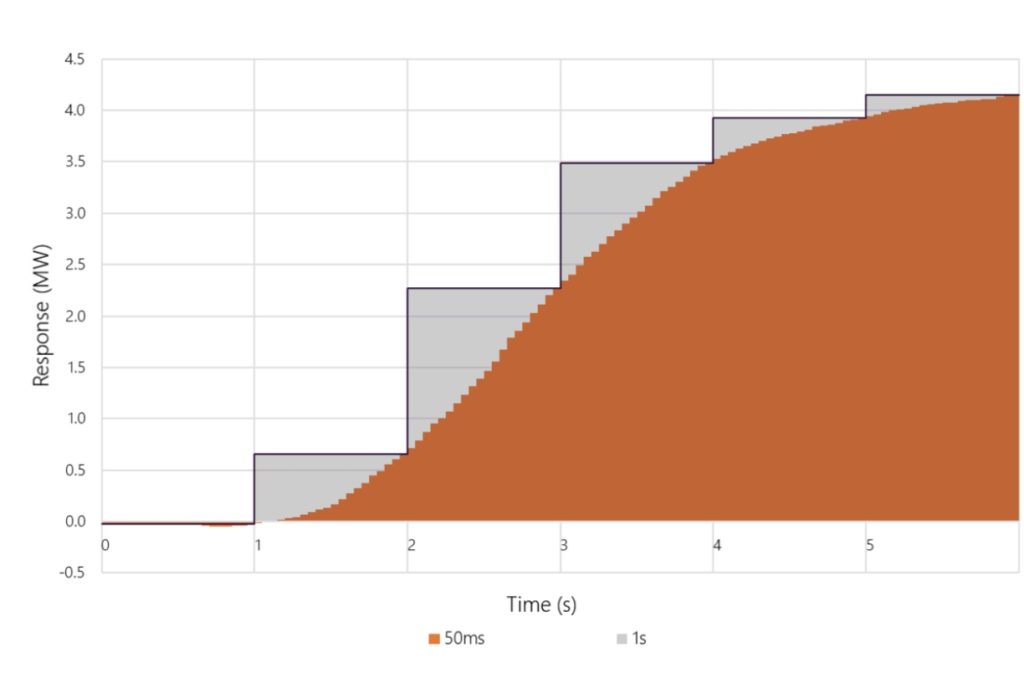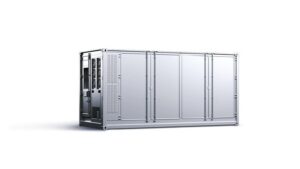Note: This article was updated on July 5 due to amendments from the contributing author. Please see details at end of article.
A small but critical development for behind-the-meter batteries and virtual power plants (VPPs) happened in June. Sellers, purchasers and owners wanting their behind-the-meter batteries to participate in FCAS (frequency control) markets need to take note.
FCAS is an important revenue source for batteries and VPPs, making a third to a half of all revenue for batteries and up to 75% for VPPs. VPPs have also proven to be a significant source of contingency reserve.
For example, last year Energy Locals and Tesla’s VPP achieved the milestone of registering 10 MW into all six contingency FCAS markets through the VPP demonstration trials.
These trials were undertaken to assess whether the standards for participation in the Frequency Control Ancillary Service (FCAS) markets – those defined by the Market Ancillary Services Specification or “MASS” – could be relaxed so that distributed energy resources (DER – think batteries, solar, controllable loads) could more easily participate in them.
Many had hoped and even assumed (as we at New Energy Ventures did) that the changes to the MASS to facilitate the VPP demonstration trial would be permanently adopted into the MASS.
On 14 June, the Australian Energy Market Operator (AEMO) released a Draft Report and Determination on whether it would change the MASS and adopt the change. In short, they have chosen not to. It has left many in the industry wondering what was the point of the VPP Demonstration trial.
Based on our work assisting businesses to set up VPPs, we think the decision by AEMO could have significant ramifications.
This will be especially so for VPPs that have been developed on the basis of the VPP demonstration FCAS specification, but also for the existing batteries and VPPs that have been installed through the VPP demonstration trials such as the Tesla Energy Locals VPP.
This article has two parts:
- In Part 1 we provide guidance on what it means to the battery and VPP industry for AEMO not to change the MASS.
- In Part 2 we present AEMO’s arguments for not changing the MASS, why we think they didn’t get the balance right and provide some solutions that might address AEMO’s concerns.
PART 1 – What’s all the fuss about the MASS?
Before we continue – we should say in advance that sorry, this topic and this article is about as “energy nerd” as it gets. I’m going to assume that if you’re reading this article you probably have at least a passing interest and understanding of FCAS markets.
For those not into the details of FCAS, jump to the end of the article for a short refresher. For those in the know, read on…
The MASS or Market Ancillary Services Specification is the technical specification that participants must meet to be able to participate in the FCAS market. They set out:
- a detailed description of each kind of market ancillary service; and
- the performance parameters and requirements that must be satisfied to qualify as a market ancillary service.
Through the VPP Demonstration Trials, AEMO was considering whether to relax the specification set out by the MASS in two key ways:
- Change the measurement of frequency and power flow from 50 millisecond to 1 second intervals for the 6 second raise and lower markets (the most valuable of each of the three raise and lower markets).
- Change the metering point from the connection point (a defined term in the National Electricity Rules in most cases meaning the point where a site connects to the grid) to the point of the inverter or controllable asset, provided certain requirements are met.
At the nub of it, both these changes would allow for more flexibility around how VPPs can supply FCAS. The change in measurement resolution would, in many cases, allow vendors to use their existing hardware and not require a dedicated meter, thereby saving on costs and complexity of an additional meter.
Furthermore, the change in metering location to allow device level metering would mean that:
- Providers of FCAS would need to be less concerned about the status of an uncontrolled load. This is especially important if the load is significantly larger than the asset providing FCAS.
- (Again) have the flexibility to incorporate power and frequency metering into the inverter and not duplicate the metering requirements.
Two solutions now exist to provide FCAS in VPPs, we’ll call them for arguments sake:
- The “Reposit solution” with main control unit FCAS measurement (see figure 1)
- The “Tesla solution” with a dedicated battery and inverter FCAS measurement point (see figure 2)
With AEMO not changing the MASS, solution 2 will no longer be an option. The implications of this are serious for companies deploying VPP technologies.
It rules out not just Tesla’s solution but other solutions in the market for residential VPPs. Tesla has argued that the cost of implementing site level metering could be as high as $15,000 (but there is some contention here as we discuss in Part 2.)’
The “Tesla solution” with main control unit FCAS measurement

So has AEMO just killed off VPPs?
Not exactly. But AEMO has definitely made it harder for VPPs and DER to participate in the FCAS markets (arguably when they should be making it easier). We don’t think AEMO has got the balance right on their decision.
The issues raised by the various respondents align closely to their technology and existing commercial positions in the market. The review also highlighted the wide gulf of technology capabilities by various VPP providers. As an example:
- Reposit Power, Landis + Gyr and Intellihub will be pleased with the outcome as their technology solutions appear to align with the current MASS standard. Their submissions made it very clear that they were not supportive of relaxing the MASS standards.
- Tesla and Evergen will no doubt be livid about the outcome. On the face of it, the VPP Demonstration trial was very informed by their technology solutions so unless AEMO concedes ground in the final determination they’ll need to innovate or be edged out of the market.
It may be possible to use embedded network arrangements to still provide device level metering but this is only practical and economic in C&I VPPs.
So what next?
We strongly recommend that those with an interest in establishing VPPs push for AEMO to accept device level metering. To that end, responding to the current consultation process in the Draft Report and Determination is advised.
The consultation process closes on 6 August. If you would like to get involved, we suggest that you read Part 2.
If there are no changes to the MASS, providers will need to work within the current technical standard to participate in FCAS markets.
Specifically, this means using metering capable of measuring power flow and frequency at 50ms and offering FCAS at a site level only. This will lift the barriers to VPPs and those barriers might be insurmountable for some battery installations.
If AEMO doesn’t budge on their decision, those businesses participating in the VPP Demonstration Project will have until 30 June 2023 to transition to the current MASS standard from the relaxed rules of the VPP Demonstration FCAS specification.
PART 2 – Detail on AEMO decision and solutions to address AEMOs concerns
This section looks at the reasons why AEMO chose not to incorporate the VPP Demonstration FCAS specification into the MASS and seeks to provide some solutions to address their concerns.
We agree with some of their justifications, but ultimately don’t think they got the balance right.
Why did AEMO not allow 1 second metering of Fast Contingency FCAS?
The main argument for 1 second metering is that 50 ms sampling of frequency and power flow is prohibitively expensive (but this is contentious – more below) meaning that it is not practical for small-scale DER. Through the trials and the consultation process, AEMO determined:
One second metering can introduce uncertainty of the order of 16% in power measurements (via Reposit Power). Below is one example of how this might happen, based on measurements from a real DER FCAS provider.
In simplified terms, the calculation of Fast FCAS payment is dependent on the average power “response” in the 6 seconds from when the frequency departs from the Normal Operating Frequency Band. Again in simplified terms, the amount of Fast FCAS delivered is a function of the “area under the curve”.
You can clearly see in the chart that 1s resolution metering means a much greater area under the curve, overestimation of energy delivered (or withdrawn) and therefore over compensation for the service delivered.

- Metering equipment for 50 millisecond resolution frequency and power data is cheaper than most had budget for. The submissions to the Review highlighted that the marginal cost of high speed metering could be as little as $120 (ref. Reposit Power) and as high as $15,000 (ref. Tesla) if FCAS metering requirements were set to 50ms. AEMO determined that if the marginal cost of meeting the 50ms standard is just $120 and could be incorporated into smart NMI meters, then there shouldn’t be a cost issue to meet the standard.
- Inverters (typically used for metering at 1 second intervals) can’t be trusted. Several respondents to the review highlighted that inverters do not respond uniformly to network faults and power system disturbances, creating power system security concerns. This looks to be an area for further investigation by AEMO.
- 50ms metering will be needed for future services for Frequency Control. Rumour is that the AEMC is considering a 1 second market for frequency response. No doubt VPP providers will want to participate in these new markets, so forcing the industry to lift its game is probably the right move.
New Energy Ventures’ view on this decision
Fair enough. Frequency control is one of the more important parts of the energy market for managing power quality and security. If a large proportion of contingency FCAS was coming from “low quality” sources, the error introduced into the power system is understandably undesirable.
If metering costs are as low as Reposit Power asserts they are, then a dedicated meter for FCAS should not be a major barrier to participation. It is concerning that there is not a lot of consensus on the metering costs, but perhaps this review will assist in converging the market.
Why did AEMO not allow the change in meter point to allow device level metering for FCAS for DERs?
The argument for device level metering over connection point metering is that you do not have to duplicate metering hardware that already exists in the inverter or control unit of, for example, a battery.
If AEMO were to allow 1 second metering and device level metering, FCAS verification metering could be performed by the inverter or control device. The arguments against device level metering are as follows:
- Metering energy at the device is not an accurate representation of the FCAS delivered to the grid. The argument is that device level metering does not account for losses and other assets could “soak up” energy delivered or absorbed from the participating device. For example, the site’s load could increase during an FCAS raise event which would result in the power being delivered at the grid being lower than the actual response from the battery.
- Potential for multiple agents coordinating devices at a single site should be avoided. The argument is that allowing device level metering means that multiple devices could all be participating in the market and either cancel each other out or conflict with each other in some way.
- Load and solar doesn’t cancel much over the measurement period so connection level metering should not be a barrier to participation. The logic here is that changes in load and solar shouldn’t impact the amount of energy dispatched from say, a battery as seen at the connection point. Therefore metering at the connection put should not be an issue.
- Device level metering could incentivize gaming of the system. AEMO is vague at best here, but I assume they mean you might have two controllable assets, one exporting and the other importing thereby providing no benefit to the grid and without interrupting a site’s operation.
New Energy Ventures’ view on this decision
In our view, the justifications for this decision are very weak and should be challenged. Limiting measurement to the connection point will make it more costly (albeit potentially marginally so) where a separate meter is required in addition to metering that is in an inverter or control unit.
In C&I VPPs there will still be the possibility of using the embedded network frameworks to place an on-market child meter on the battery. This arrangement will enable access by the C&I batteries into the FCAS at a device level through the creation of a new connection point. (The ESB is even considering whether to formalise these arrangements with Flexible Trading Relationships).
But it is not practical and economic for residential VPPs to use this arrangement as it financially isolates the battery from the solar, removing the battery’s ability to provide solar storage. Device level metering can and should be considered to enable more flexibility for VPPs to provide their services.
We spell out some remedies for AEMO’s concerns below.
Addressing AEMO’s concerns regarding site level metering
We agree that settlement needs to be done at a connection point level but the issues raised can be dealt with through a series of practical measures to allow for metering at a device level:
- If losses exist between the device and the connection point, this can and should be addressed by measuring the losses and applying a discount factor to the energy dispatched. There is precedence for this approach with the use of Marginal Loss Factors (MLFs) in the broader National Electricity Market. Generators at the end of a long skinny line will only get paid for what reaches the market, not what is generated at the terminal or connection point thereby accounting for the losses. The same approach could be applied where the losses between the asset providing FCAS and the connection point of the site are applied as a discount to the volume of services. Alternatively, AEMO could propose a standard, conservative, value for this for small DER devices to avoid the overhead of measuring losses at every new FCAS installation.
- If multiple participating devices at a site could present an issue, limit participation to either whole-of-site level or a single device. This at least gives some flexibility about how to meter for FCAS and for vendors to offer their services. Trying to solve for multiple participants behind-the-meter is pre-emptive and well beyond the current status of the market and should be considered in the future.
- Regardless of where the device is in the system, it is electrically connected to part of the system. Once accounting for losses is configured (see point 1 above), an asset should be compensated for its services. Metering at a site level can mask a low-cost, high value contribution to FCAS where the participating asset is significantly smaller than the load of the site it’s located within, especially in a C&I context.
- Gaming the market can be dealt with through clear requirements and penalties that already exist. CS Energy just recently was fined $200,000 for being unable to deliver on it’s bids. Frankly, there is a strong incentive anyway to actively participate in rather than game the system if you have that much control of your load.
Not adopting asset level metering has been made unnecessarily more difficult than it needs to be and limits important innovation in VPPs.
In the context of the National Energy Objective, making it harder for VPPs to participate in the market is not a good outcome for consumers. Specifically:
- Allowances for asset level metering will bring more resource options into the mix. More supply with fixed demand ultimately means reduced prices for FCAS and therefore prices in the grid. VPPs have the advantage of not needing to recover all their costs through wholesale market and FCAS markets’ participation as grid scale batteries do. Therefore they should be able to supply FCAS at much lower cost.
- Reliability of the grid is potentially impacted because we have services delivered by a small number of assets. The strength of VPPs is the diversification of their resources. Diversification ultimately leads to more resilience and better security of supply. (If you need a case study for grids without good diversification of resources, look no further than the recent history of blackouts in South Australia.)
- Quality and safety of supply should not be impacted if AEMO deals with losses as we outline above.
Note: This article initially stated that commercial and industrial VPPs would be greatly affected by AEMO not adopting the VPP Demonstration FCAS specification into the MASS. On further analysis, New Energy Ventures determined that it will still be possible to do device level metering through the application of the embedded network frameworks and the creation of child metering points on devices intending to participate in the FCAS market. This approach is only practical and economic for C&I VPPs given the nature of the value stack. In general the arguments hold true more generally for VPPs and that AEMO should reconsider its position. The article was updated on July 5.
James Allston is the founder and managing director of New Energy Ventures (NEV), a specialist management consultancy and data-driven services provider that specialises in new energy technology and service models.
NEV provides advice on the commercial, technical and regulatory aspects of virtual power plants and is working with many of Australia’s leading energy companies to develop them.
FCAS explained
There are eight Frequency Ancillary Service Markets (FCAS), two for regulation FCAS (used to raise and lower frequency, updating every 4 seconds) and six for contingency FCAS markets (used to raise and lower frequency back to normal limits over time periods of 6 seconds, 60 seconds or 5 minutes). The FCAS markets’ role in the energy market is to keep the frequency within an acceptable range around 50Hz (The Normal Operating Frequency Band is 49.85Hz to 50.15Hz to be precise). The frequency of the market changes due to mismatches in supply and demand. Too much supply (generation) and the frequency goes up, too much demand (load) and the frequency goes down.
The contingency markets are especially interesting. They are capacity markets, meaning participants are paid to sit and wait for a contingency event to happen. By “contingency event” we mean a frequency deviation caused by large disruption to the grid like a transmission line getting knocked out, a coal fired power plant tripping, or a cloud going over the sun. When this happens, providers of FCAS need to very quickly respond and fill the gap between the supply and demand created by the event.











